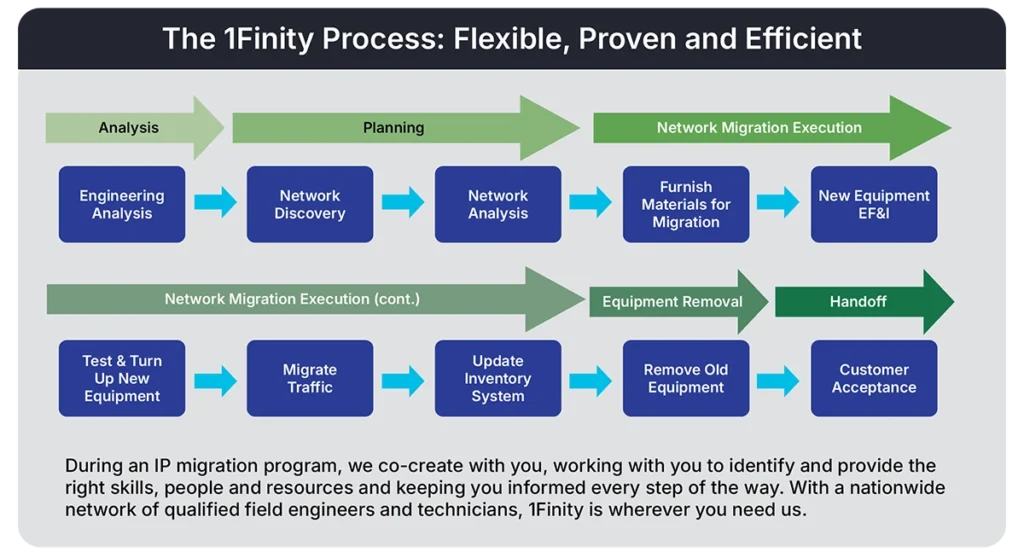
With a well-defined roadmap, it’s easier than you think
For Tier 1 and Tier 2 telecoms, network modernization has long been seen as critical for helping services providers transition from older legacy technology to more efficient and capable IP-based systems. This is especially important as networks become increasingly more complex and sprawling. There are multiple aspects to network modernization, including:
- Updating hardware and software infrastructure
- Redesigning network architectures for faster scaling
- Implementing advanced security protocols
- Building a foundation for automation and AI
Large modernization initiatives often include a broad mix of these strategies. In fact, the facets of network modernization are so broad that understanding where to begin can be difficult. Then again, with the potential to create an all-IP network that’s faster, more efficient and resilient, and more cost-effective, service providers are under pressure to get going. The question is, how?
The network layer as a starting point for network modernization
Within the OSI network stack, the networking layer (Layer 3) is responsible for managing end-to-end connections by routing data frames between networks. Using network protocols including Internet Protocol (IP), Internet Control Message Protocol (ICMP) and Multi-Protocol Label Switching (MPLS), the network layer assigns logical IP addresses and calculates the best routing path for each data packet.
The main roles of the network layer include:
- Structuring data into packets for transmission
- Assigning a source and destination IP address to each packet
- Determining the best path for packets via routing protocols
- Moving packets between endpoints and across networks
- Controlling network congestion and managing quality of service performance
As telecom networks grow more complex, the networking layer (a.k.a. IP layer) has become increasingly more important due to its ability to direct and manage the flow of data packets across multiple LANs and VLANs. This is largely due to the capabilities of Layer 3 switches that combine the functions of a switch and router, enabling networks to take advantage of enhanced efficiencies.
Benefits of IP Network Modernization
- Improve security, routing and resilience
- Simplify management of subnets and routing
- Increase transmission speed, reduce latency
- Reduce CAPEX, power and space costs
- Improve bandwidth utilization and efficiency
- Enhance scalability and network agility
For example, Layer 3 switches incorporate routing tables that determine the most efficient paths for data across subnets. Layer 3 switches also support dynamic routing, enhancing the switch’s ability to manage traffic effectively. Using inter-VLAN routing, these switches also facilitate communication between VLANs within the same network, often eliminating the need for separate routers. By handling complex end-to-end routing details, the network layer enables the upper layers to focus on transmitting packets between endpoints. The point is that much of the potential of network modernization is associated in some way with Layer 3 functionality. Thus, adapting and modernizing this layer is a good place to start a broader network modernization initiative.
Anatomy of an IP modernization project
In practice, an IP modernization project involves several key steps: analyzing the legacy network layer, planning, and designing the new one, installing and turning up the new equipment, migrating traffic from the legacy equipment to the new equipment, updating all inventory systems (including OSS records), and removing the old equipment. The overall goal is a fast, efficient, and cost-effective migration from the legacy Layer 3 environment to the new IP environment.
But while the benefits of IP modernization are both significant and well documented, Tier 1 and Tier 2 service providers have been hesitant to go all in. Lack of enough time, resources, skills, and bandwidth are probably the biggest reasons, and for good reasons.
Across the telecom ecosystem, schedules are tight, and budgets are even tighter. Internal teams are already stretched thin, and, even if network managers had more people, there are few with the TDM and TL1 skillsets needed for a seamless IP migration. And those aren’t the only things in short supply. Offices are crowded with equipment inherited after years of acquisition. Telecom network need to free up floor space and power, get leaner and more efficient.
1Finity IP network modernization services
1Finity’s IP Network Modernization Services enables service providers to transform their networks in the most efficient way possible. 1Finity provides the expertise, resources and experience needed to complete your IP network modernization on time and within budget. Experts in Layer 3 transformation, we offer customizable, end-to-end capabilities that maximize project efficiency while minimizing risk during live traffic migration.
Fully capable and experienced in turnkey project design, implementation, and management, we work with you to fill the gaps in your internal resources. With a nationwide network of qualified field engineers and technicians, 1Finity is wherever you need us.
The IP migration process
Over the course of 1800+ successful network modernization projects since 2014, 1Finity has developed proven processes, procedures, and automation tooling. Projects are guided by PMI-certified program managers and aided by IP traffic migration teams, solution architects and engineers with deep Nokia, Juniper, and Cisco expertise.

Analysis
This initial phase begins with a pre-quote engineering analysis of your existing network devices that results in multiple migration scenarios.
Deliverables: Report and review of network analysis findings and recommendations; proposed project scope, plan review, project quote (where applicable) and customer acceptance.
Planning
1Finity performs a thorough network discovery, gathering circuit details that inform the network analysis. During network analysis the network’s architecture and design are developed along with site-specific MOPs and engineering cut sheets.
Deliverables: Review of Network Discovery findings, BOM, Project timeline, acceptance testing plan including test cases review and signoff
Network migration
1Finity engineers, furnishes, and installs (EF&I) the new equipment, then configures, tests, and turns it up. After turn-up, we perform a physical and logical migration of circuits from your old equipment to the new equipment and update the inventory system, including OSS records, to match the new topology.
Deliverables: Updated and detailed post-migration cut sheets, review of acceptance testing results and customer signoff
OSS Inventory Records Update
During migration we update all circuit paths, provision new hardware, decommission old hardware, and reconcile any anomalies. Updated OSS records reflect changes as they are completed.
Equipment removal
After migration is confirmed and approved, 1Finity plans and executes the physical power-down and removal of your old hardware and frames.
Deliverables: Plan, review and sign-off of equipment removal SOW and process
Handoff
Updated network handed over to customer.
Deliverables: Closeout package and customer acceptance
Proven processes and automation tooling
Throughout the IP migration, 1Finity leverages our proven proprietary processes, automation, and tooling to keep your project on schedule and within budget. Our clearly defined processes include:
- Project kickoff
- Project closeout
- CIQ
- Materials calculations
- MOPs
- Master design sheets
- Engineering drawings
- Connection maps
- Customer acceptance
1Finity is continually developing process-based and customer-based tooling to and automation to help improve migration efficiency and speed.
For example, our Digital Annealer optimizes migration planning by accelerating generation of optimal migration sequences. Other technologies include intelligent tunnel engineering, iOCR and our maintenance engineering portal that enables customers to temporarily house your process information during the project.
Bottom-line benefits of partnering with 1Finity
1Finity’s IP Network Modernization Services are highly customizable and scalable. With turnkey and ala carte services, you can tailor an IP migration project based on your resource availability, schedule, and in-house skillsets. With a national network of engineers, technicians and solution architects, 1Finity enables you to scale your migrations across several regions quickly and seamlessly.
By delivering a best-fit solution for any IP migration project, 1Finity enables service providers to accelerate turn up of their new networking layer and return on their investment. Using the same rigorous processes, tools and talent across multiple regions and migrations, 1Finity ensures uniform and repeatable results for great efficiency and cost-effectiveness.
Finally, as a true multi-vendor provider, 1Finity gives you one vendor, one point of contact and total accountability. Put it all together and you’ve one experienced and trusted partner who can help transform your network from where it is to where you need it to be.